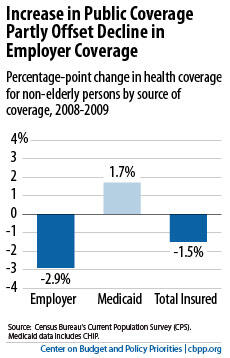off the charts
POLICY INSIGHT
BEYOND THE NUMBERS
BEYOND THE NUMBERS
Census Also Released Health Insurance Numbers Today
Receive the latest news and reports from the Center
Today’s Census Bureau report shows that the number and share of Americans without health insurance rose by 4.3 million and 1.3 percentage points, respectively — the largest single-year increases on record on data that begin in 1999.
The increases were driven by a decline in private health coverage resulting from large reductions in employer-based coverage, which have been occurring for a number of years but accelerated sharply in 2009. Just 58.9 percent of the non-elderly population had employer coverage in 2009, compared to 67.8 percent in 1999.

While the share of working-age adults lacking coverage went up, the share of children lacking coverage didn’t, thanks to a large increase in the number of children covered through Medicaid and the Children’s Health Insurance Program. The different outcomes for children and adults illustrate the importance of health reform, which will give adults much of the improved access to affordable coverage through both private and public health care programs that children already enjoy.
The Congressional Budget Office estimates that by 2019, these provisions will enable 32 million otherwise-uninsured Americans to obtain health coverage. Had these provisions been in effect in 2009, the increase in the number of uninsured Americans would unquestionably have been much smaller.